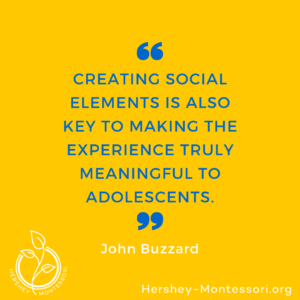Hershey Guide Shares Keys to Supporting Montessori Education Online
“For the adolescent, it is critical that we make our learning child-directed and that we continue to make student choices a priority.” ~John Buzzard
Hershey’s John Buzzard recently shared with the International Montessori Training Institute how he’s transitioned his Upper School Integrated Humanities projects to a distance, online education learning model. Below is an excerpt of what Buzzard wrote:
Because we value face-to-face, social interaction and hands-on learning in Montessori education, we must strive to keep these as key elements of the learning process, despite our current social distancing situation. This requires some adjustments, but can still be accomplished. As we consider our move towards working with our students in an online education environment, we should pause to consider how to make this approach as true to the Montessori pedagogy as possible. Even using technology and new methodologies, we know that the truths of Montessori remain valid and will want to design our educational program with them in mind.
For the adolescent, it is critical that we make our online education child-directed and that we continue to make student choices a priority. Our choice of strategies in the online environment can be shaped by philosophy, and just as in other environments, we find teacher-centered learning and student-centered learning occurring. Because students are working more independently, there are many ways to structure the learning to be student-centered, and we want to take advantage of the computer and the students’ home environment to emphasize these possibilities.
Creating social elements is also key to making the online learning experience truly meaningful to adolescents. Don’t merely focus on academic interactions – think closely about how to use video, dialogue, discussion, and activities to build connection and social dynamics with the group. Although we accept that this will be a less authentic community experience than actual face-to-face interaction, we must continue to make that element of adolescent development primary.
As always, there is a tension between the need for student-centered learning and the need for a prepared environment. In a Montessori school, guides know that maximizing student choice often begins with carefully constructed environments and experiences. We must shift this thinking to the online world, creating prepared virtual environments and experiences that continue to support student learning without superseding it.
Ultimately it is the three-stage learning cycle that shows us the way to structuring our online education environment. This approach maximizes student choice while providing the prepared environment structure that students need to do their best work. This three-stage cycle is built on three natural stages to the learning process – key lessons, individual research, and meaningful presentation.
This approach maximizes student choice while providing the prepared environment structure that students need to do their best work.
Read John Buzzard’s detailed lay out of the three-stage learning cycle here.


